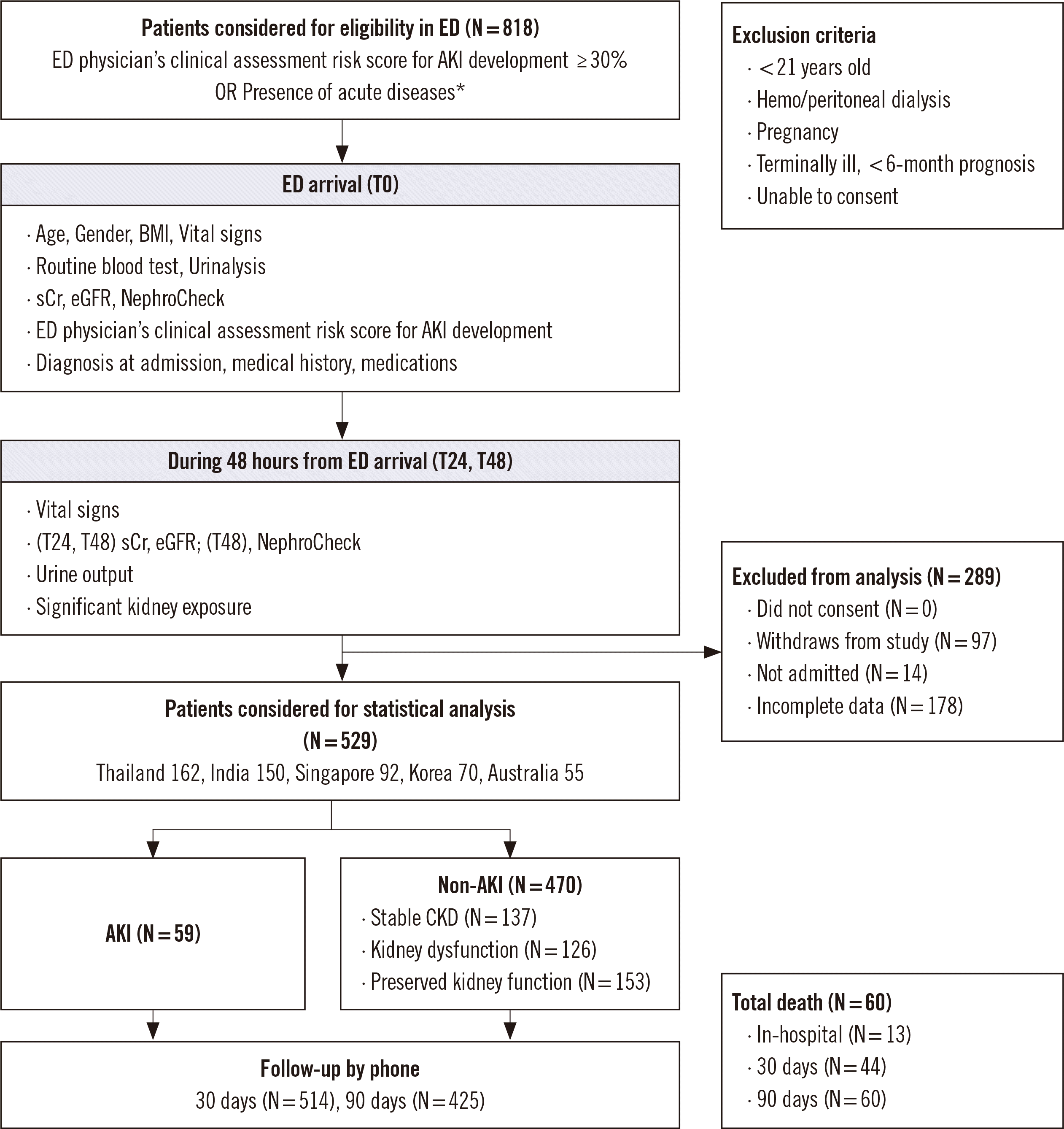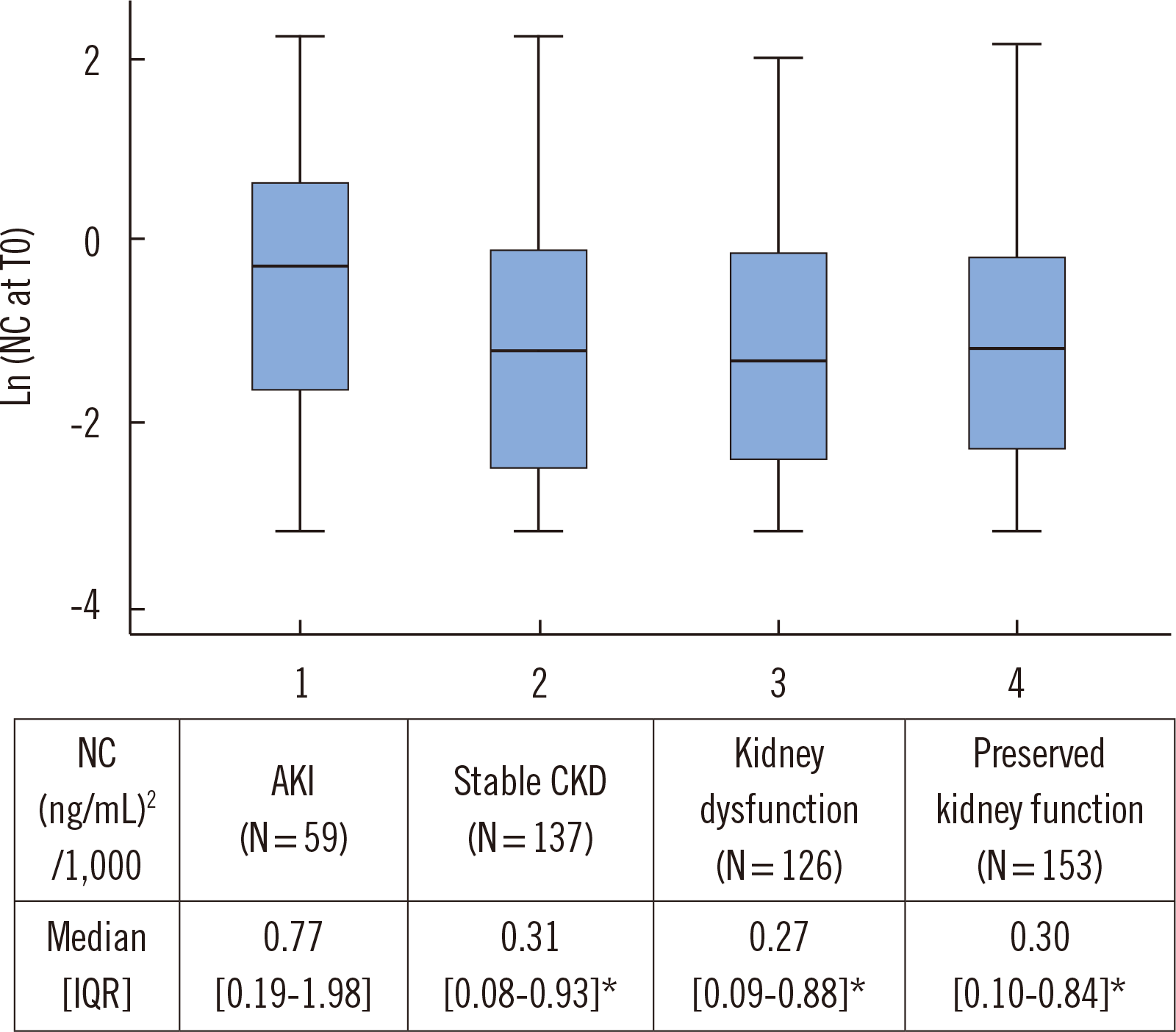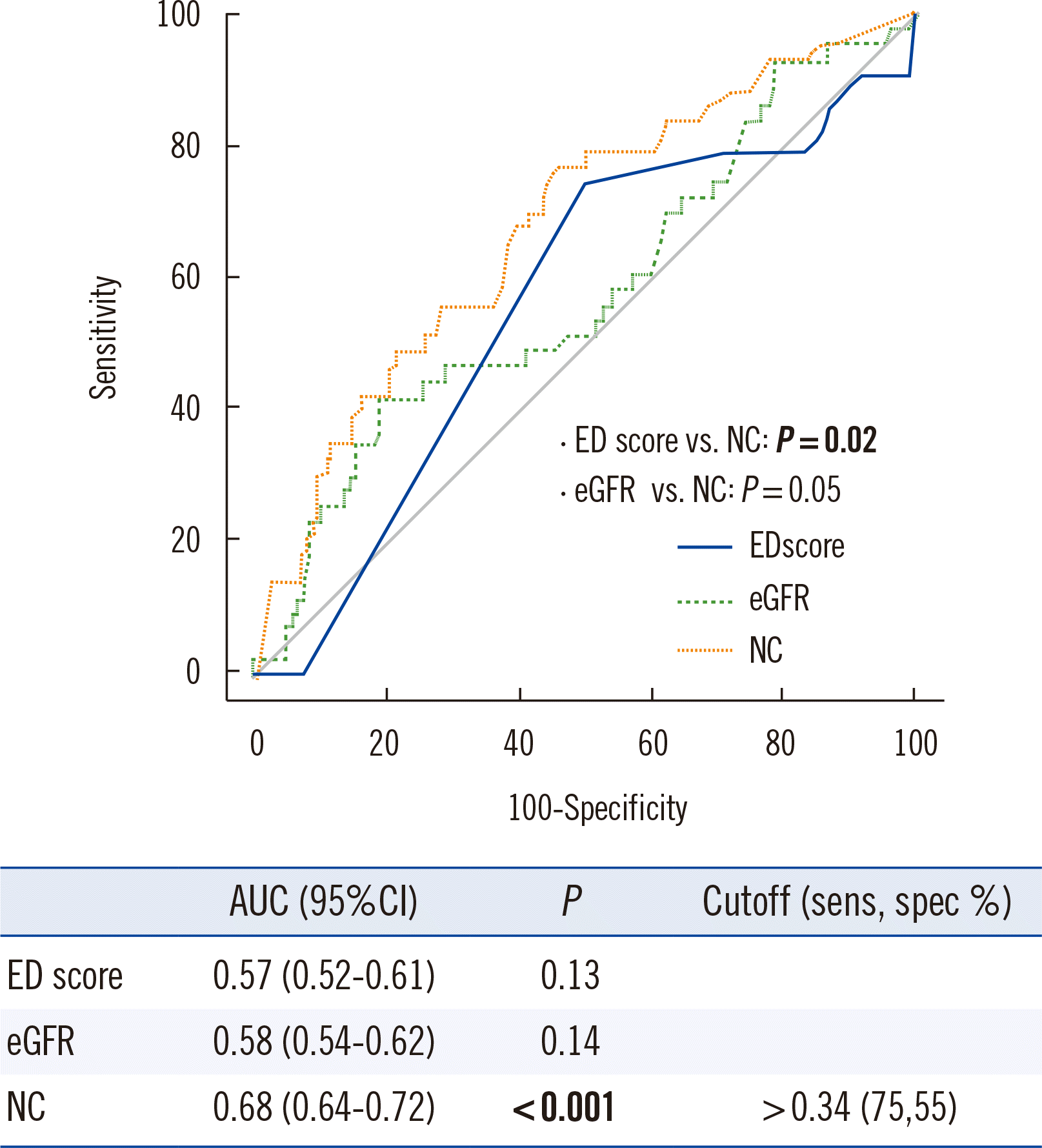1. Susantitaphong P, Cruz DN, Cerda J, Abulfaraj M, Alqahtani F, Koulouridis I, et al. 2013; World incidence of AKI: a meta-analysis. Clin J Am Soc Nephrol. 8:1482–93. DOI:
10.2215/CJN.00710113. PMID:
23744003. PMCID:
PMC3805065.

2. Hoste EA, Bagshaw SM, Bellomo R, Cely CM, Colman R, Cruz DN, et al. 2015; Epidemiology of acute kidney injury in critically ill patients: the multinational AKI-EPI study. Intensive Care Med. 41:1411–23. DOI:
10.1007/s00134-015-3934-7. PMID:
26162677.

4. Meersch M, Schmidt C, Hoffmeier A, Van Aken H, Wempe C, Gerss J, et al. 2017; Prevention of cardiac surgery-associated AKI by implementing the KDIGO guidelines in high risk patients identified by biomarkers: the PrevAKI randomized controlled trial. Intensive Care Med. 43:1551–61. DOI:
10.1007/s00134-016-4670-3. PMID:
28110412. PMCID:
PMC5633630.

5. Cervellin G, di Somma S. 2012; Neutrophil gelatinase-associated lipocalin (NGAL): the clinician's perspective. Clin Chem Lab Med. 50:1489–93. DOI:
10.1515/cclm-2012-0433. PMID:
23096016.

6. Mehta RL, Kellum JA, Shah SV, Molitoris BA, Ronco C, Warnock DG, et al. 2007; Acute Kidney Injury Network: report of an initiative to improve outcomes in acute kidney injury. Crit Care. 11:R31. DOI:
10.1186/cc5713. PMID:
17331245. PMCID:
PMC2206446.

7. Teixeira C, Garzotto F, Piccinni P, Brienza N, Iannuzzi M, Gramaticopolo S, et al. 2013; Fluid balance and urine volume are independent predictors of mortality in acute kidney injury. Crit Care. 17:R14. DOI:
10.1186/cc12484. PMID:
23347825. PMCID:
PMC4057508.

8. Bellomo R, Ronco C, Kellum JA, Mehta RL, Palevsky P. Acute Dialysis Quality Initiative Workgroup. 2004; Acute renal failure-definition, outcome measures, animal models, fluid therapy and information technology needs: the Second International Consensus Conference of the Acute Dialysis Quality Initiative (ADQI) Group. Crit Care. 8:R204–12. DOI:
10.1186/cc2872. PMID:
15312219. PMCID:
PMC522841.
9. Thomas ME, Blaine C, Dawnay A, Devonald MA, Ftouh S, Laing C, et al. 2015; The definition of acute kidney injury and its use in practice. Kidney Int. 87:62–73. DOI:
10.1038/ki.2014.328. PMID:
25317932.

10. Endre ZH, Pickering JW, Walker RJ. 2011; Clearance and beyond: the complementary roles of GFR measurement and injury biomarkers in acute kidney injury (AKI). Am J Physiol Renal Physiol. 301:F697–707. DOI:
10.1152/ajprenal.00448.2010. PMID:
21753074.

11. Kashani K, Al-Khafaji A, Ardiles T, Artigas A, Bagshaw SM, Bell M, et al. 2013; Discovery and validation of cell cycle arrest biomarkers in human acute kidney injury. Crit Care. 17:R25. DOI:
10.1186/cc12503. PMID:
23388612. PMCID:
PMC4057242.

12. Fan W, Ankawi G, Zhang J, Digvijay K, Giavarina D, Yin Y, et al. 2019; Current understanding and future directions in the application of TIMP-2 and IGFBP7 in AKI clinical practice. Clin Chem Lab Med. 57:567–76. DOI:
10.1515/cclm-2018-0776. PMID:
30179848.

13. Bihorac A, Chawla LS, Shaw AD, Al-Khafaji A, Davison DL, Demuth GE, et al. 2014; Validation of cell-cycle arrest biomarkers for acute kidney injury using clinical adjudication. Am J Respir Crit Care Med. 189:932–9. DOI:
10.1164/rccm.201401-0077OC. PMID:
24559465.

15. Vijayan A, Faubel S, Askenazi DJ, Cerda J, Fissell WH, Heung M, et al. 2016; Clinical use of the urine biomarker [TIMP-2]×[IGFBP7] for acute kidney injury risk assessment. Am J Kidney Dis. 68:19–28. DOI:
10.1053/j.ajkd.2015.12.033. PMID:
26948834. PMCID:
PMC4921267.
16. Ilaria G, Kianoush K, Ruxandra B, Francesca M, Mariarosa C, Davide G, et al. 2021; Clinical adoption of Nephrocheck in the early detection of acute kidney injury. Ann Clin Biochem. 58:6–15. DOI:
10.1177/0004563220970032. PMID:
33081495.

17. McCullough PA, Nowak RM, McCord J, Hollander JE, Herrmann HC, Steg PG, et al. 2002; B-type natriuretic peptide and clinical judgment in emergency diagnosis of heart failure: analysis from Breathing Not Properly (BNP) Multinational Study. Circulation. 106:416–22. DOI:
10.1161/01.CIR.0000025242.79963.4C. PMID:
12135939.
18. Di Somma S, Magrini L, De Berardinis B, Marino R, Ferri E, Moscatelli P, et al. 2013; Additive value of blood neutrophil gelatinase-associated lipocalin to clinical judgement in acute kidney injury diagnosis and mortality prediction in patients hospitalized from the emergency department. Crit Care. 17:R29. DOI:
10.1186/cc12510. PMID:
23402494. PMCID:
PMC4056001.

20. Janssens ACJW, Martens FK. 2020; Reflection on modern methods: revisiting the area under the ROC curve. Int J Epidemiol. 1397–403. DOI:
10.1093/ije/dyz274. PMID:
31967640.

21. Pencina MJ, D'Agostino Sr RB, D'Agostino RB Jr, Vasan RS. 2008; Evaluating the added predictive ability of a new marker: from area under the ROC curve to reclassification and beyond. Stat Med. 27:157–72. discussion 207–12. DOI:
10.1002/sim.2929. PMID:
17569110.

22. Kimmel M, Shi J, Latus J, Wasser C, Kitterer D, Braun N, et al. 2016; Association of renal stress/damage and filtration biomarkers with subsequent AKI during hospitalization among patients presenting to the emergency department. Clin J Am Soc Nephrol. 11:938–46. DOI:
10.2215/CJN.10551015. PMID:
27026519. PMCID:
PMC4891754.

23. Schanz M, Shi J, Wasser C, Alscher MD, Kimmel M. 2017; Urinary [TIMP-2] × [IGFBP7] for risk prediction of acute kidney injury in decompensated heart failure. Clin Cardiol. 40:485–91. DOI:
10.1002/clc.22683. PMID:
28295429. PMCID:
PMC6490429.
24. Schanz M, Wasser C, Allgaeuer S, Schricker S, Dippon J, Alscher MD, et al. 2019; Urinary [TIMP-2]∙[IGFBP7]-guided randomized controlled intervention trial to prevent acute kidney injury in the emergency department. Nephrol Dial Transplant. 34:1902–9. DOI:
10.1093/ndt/gfy186. PMID:
29961888.

25. Hoste EA, Lameire NH, Vanholder RC, Benoit DD, Decruyenaere JM, Colardyn FA. 2003; Acute renal failure in patients with sepsis in a surgical ICU: predictive factors, incidence, comorbidity, and outcome. J Am Soc Nephrol. 14:1022–30. DOI:
10.1097/01.ASN.0000059863.48590.E9. PMID:
12660337.

26. Johnson ACM, Zager RA. 2018; Mechanisms underlying increased TIMP2 and IGFBP7 urinary excretion in experimental AKI. J Am Soc Nephrol. 29:2157–67. DOI:
10.1681/ASN.2018030265. PMID:
29980651. PMCID:
PMC6065093.

28. McCullough PA, Shaw AD, Haase M, Bouchard J, Waikar SS, Siew ED, et al. 2013; Diagnosis of acute kidney injury using functional and injury biomarkers: workgroup statements from the tenth Acute Dialysis Quality Initiative Consensus Conference. Contrib Nephrol. 182:13–29. DOI:
10.1159/000349963. PMID:
23689653.

29. Albert C, Haase M, Albert A, Zapf A, Braun-Dullaeus RC, Haase-Fielitz A. 2021; Biomarker-guided risk assessment for acute kidney injury: time for clinical implementation? Ann Lab Med. 41:1–15. DOI:
10.3343/alm.2021.41.1.1. PMID:
32829575. PMCID:
PMC7443517.

30. Göcze I, Jauch D, Götz M, Kennedy P, Jung B, Zeman F, et al. 2018; Biomarker-guided intervention to prevent acute kidney injury after major surgery: the prospective randomized BigpAK study. Ann Surg. 267:1013–20. DOI:
10.1097/SLA.0000000000002485. PMID:
28857811.
31. Chawla LS, Bellomo R, Bihorac A, Goldstein SL, Siew ED, Bagshaw SM, et al. 2017; Acute kidney disease and renal recovery: consensus report of the Acute Disease Quality Initiative (ADQI) 16 Workgroup. Nat Rev Nephrol. 13:241–57. DOI:
10.1038/nrneph.2017.2. PMID:
28239173.

32. Lin J, Fernandez H, Shashaty MG, Negoianu D, Testani JM, Berns JS, et al. 2015; False-positive rate of AKI using consensus creatinine-based criteria. Clin J Am Soc Nephrol. 10:1723–31. DOI:
10.2215/CJN.02430315. PMID:
26336912. PMCID:
PMC4594067.

33. El-Khoury JM, Hoenig MP, Jones GRD, Lamb EJ, Parikh CR, Tolan NV, et al. 2021; May. 11. AACC Guidance Document on laboratory investigation of acute kidney injury. J Appl Lab Med. jfab020. doi: 10.1093/jalm/jfab020. Online ahead of print. DOI:
10.1093/jalm/jfab020. PMID:
33973621.

34. Yeh HC, Lo YC, Ting IW, Chu PL, Chang SN, Chiang HY, et al. 2020; 24-hour serum creatinine variation associates with short- and long-term all-cause mortality: a real-world insight into early detection of acute kidney injury. Sci Rep. 10:6552. DOI:
10.1038/s41598-020-63315-x. PMID:
32300213. PMCID:
PMC7162857.








 PDF
PDF Citation
Citation Print
Print




 XML Download
XML Download